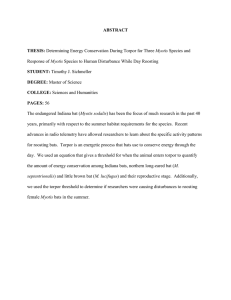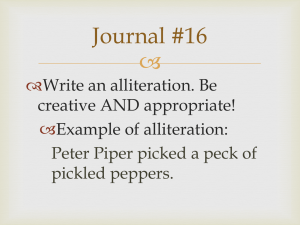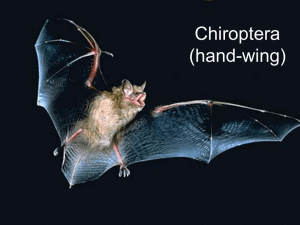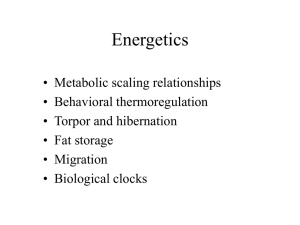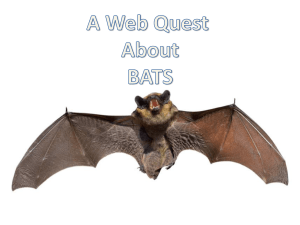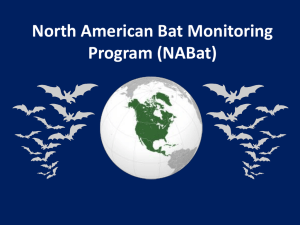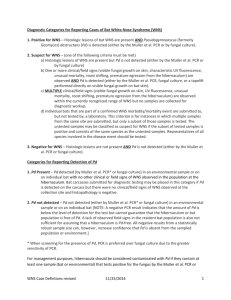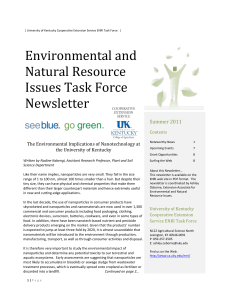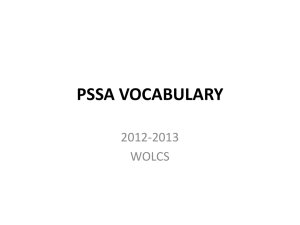Bat White Nose 1 - Kolos
advertisement
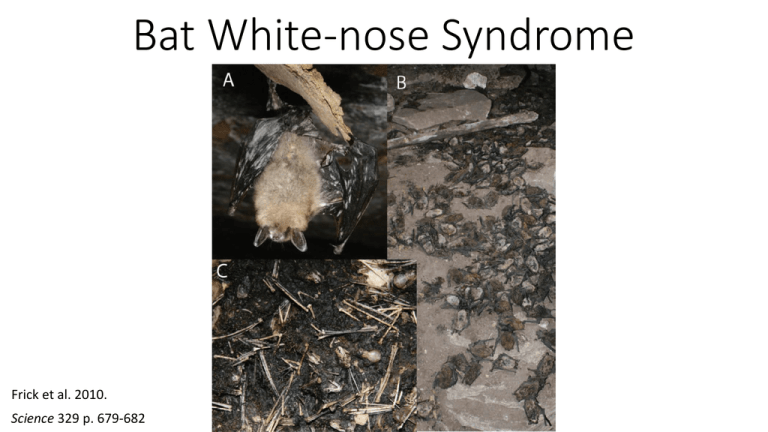
Bat White-nose Syndrome Frick et al. 2010. Science 329 p. 679-682 Outline • What is White-nose Syndrome? • Affected Bat Species • Rapid Spread • Why Should We Care? • Causative Agent • Geomyces destructans • Morphology • Pathology of Infection • Why Does Infection Lead to Death? • Effects on Torpor and Arousal Patterns • Dehydration? • Combating the Disease • Rhodococcus rhodochrous? Hibernating Indiana bat (Myotis sodalis) Photo Credit: USFWS/Ann Froschauer What is WNS? • Infectious disease affecting North American hibernating bat species • White fungal growth on muzzle, ears, and wing membranes • Novel pathogen hypothesis; causing unprecedented mass mortality Bat species affected by WNS: Bat species affected by WNS: • Big brown bat (Eptesicus fuscus) • Bat species on which fungus has been detected: • Cave bat (Myotis velifer) • Eastern small-footed bat (Myotis leibii) • Southeastern bat (Myotis austroriparius) • Gray bat (Myotis grisescens) *endangered • Indiana bat (Myotis sodalis) *endangered • Little brown bat (Myotis lucifugus) • Northern long-eared bat (Myotis septentrionalis) • Tricolored bat (Perimyotis subflavus) • Virginia Big-Eared Bat (Corynorhinus townsendii virginianus) *endangered • Federally listed species found in the affected area that have not yet been confirmed with WNS or fungal infection: • Ozarks big-eared bat (Corynorhiunus townsendii ingens) *endangered Rapid Spread of WNS Why Should We Care? • Insectivorous bats-primary consumers of night-flying insects • Provide natural pest-control services • Valued at approximately $22.9 billion dollars per year to the United States agricultural industry (Boyles and Willis 2010, Reeder et al. 2012) Causative Agent: A Fungal Pathogen • Geomyces destructans sym. Pseudogymnoascus destructans • Phylum: Ascomycota • Class: Dothideomycetes • Order: Incerti ordinis (Undefined Order) • Family: Pseudeurotiaceae • Psychrophilic (cold-loving) fungus • optimal growth observed between 4oC and 15oC • Soil-living fungus • Can persist in the environment without a bat host Chaturvedi et al. 2010 G. Destructans Morphology and Molecular Characteristics • Septate hyphae • Conidium borne in whorls directly on hyphae without any fruiting bodies • Asymmetrical curved conidia* • unique and not found in other species of Geomyces • Molecularly Produce: • Proteolytic and hydrolyzing enzymes • Enchance growth in optimal conditions • Proteinases • Implicated as virulence traits in a variety of microbial pathogens Gargas et al. 2009. Mycotaxon 108 p. 147-157 Chaturvedi et al. 2010. Pathology of Infection • Fungal hyphae replace: • hair follicles • sebaceous and sweat glands • Breach wing basement membrane and invade regional tissue. • Hyphae also eroded the epidermis of ears and wings Wibblet al. 2010 Cryan et al. 2010 Why Does Infection Lead To Death? • Hibernation Preparation • Fat Stores • Torpor Bouts • Last 12 to 19 days • Brief Arousal Periods • Last 1-2 hours • Consume 80-90% energy needed to survive hibernation • Infected bats appear emaciated and have lost all of their fat stores • Some found outside of caves during hibernation period • Flying around during the day Effects on Torpor and Arousal Patterns • Abnormally short torpor bouts due to frequent arousal periods • Reduced immune response Reeder et al. 2010 Why are infected bats spending more time out of torpor? • Multiple possibilities: Large area of current research • Bats intensify grooming because of skin irritation • Need to increase body temperature to mediate an immune response • One leading hypothesis: Dehydration • Evaporative water loss during hibernation leads to dehydration over time and eventually triggers rewarming and arousal periods • Wing damage caused by G. destructans elevate cutaneous water loss reducing the amount of time bats are able to spend in torpor before dehydration triggers arousal Combating the Disease Maine Department of Inland Fisheries and Wildlife wildlife biologist survey a cave in Oxford County, Maine, for white-nose syndrome. The disease was confirmed to be present on bats from that location. Credit: Jonathan Mays, Wildlife Biologist, Maine Department of Inland Fisheries and Wildlife Bats with temperature-sensitive radio transmitters, Shindle Iron Mine, Pennsylvania Credit: Greg Turner, Pennsylvania Game Commission New Hope? • “The Enemy of My Enemy is My Friend” • Rodococcus rhodochrous • Strain DAP96253 • Biological antagonist of G. destructans • Inhibits fungus without actually touching the bats or cave structures • Inhibited growth by blocking germination of spores at 15oC • Experimentally prevented the colonization of fungal spores on wing tissue for more than 40 days • Could be placed on plastic sheets near hibernating bats • When bats no longer at risk (spring and summer) it could be easily removed Summary • WNS is an infectious disease resulting in unprecedented mass mortality of hibernating bat species in North America caused by the invasive psychrophilic soil fungal pathogen Geomyces destructans • Infection disrupts torpor and arousal patterns during hibernation which depletes critical fat stores needed for bats to survive • Current research is focused on explaining abnormal arousal periods; leading hypothesis dehydration • Combating the disease is difficult due to sensitive cave ecosystems • Currently: management, hibernacula protection, and collaborative research • New hope?: Natural microbial antagonists? Questions? Literature Cited • Blehert, D.S., Hicks, A.C., Behr, M., Meteyer, C.U., Berlowski-Zier, B.M., Buckles, E. L., Coleman, T.H., Darling, S.R., Gargas, A., Niver, R., Okoniewski, J.C., Rudd, R.J., Stone, W.B. 2009. Bat White-nose syndrome: An emerging fungal pathogen? Science, 323, p. 227. • Boyles, J.G. and Willis, C.K.R. 2010. Could localized warm areas inside cold caves reduce mortality of hibernating bats affected by white-nose syndrome? Front Ecol Enivron 8:2 p. 92-98. • Chaturvedi, V., Springer, D.J., Behr, M., Ramani, R., Li, X., Peck, M.K., Ren, P., Bopp, D.J., Wood, B., Samsonoff, W.A., Butchkoski, C.M., Hicks, A.C., Stone, W.B., Rudd, R.J., and Chaturvedi, S. 2010. Morphological and molecular characterizations of psychrophilic fungus Geomyces destructans from New York Bats with White Nose Syndrome (WNS). PLoS ONE 5:5 e10783. • Cryan P.M., Meteyer, C.U., Boyles, J.G., and Blehert, D.S. 2010 Wing pathology of white-nose syndrome in bats suggest lifethreatening disruption of physiology. BMC Biology 8: 135. • Frick, W.F., Pollock, J.F., Hicks, A.C., Langwig, K.E., Reynolds, D.S., Turner, G.G., Butchkoski, C.M., and Kunz, T.H. 2010. An emerging disease causes region population collapse of a common North American bat species. Science 329, p. 679-682. • Gargas, A., Trest, M.T., Christensen, M., Volk, T.J., and Blehert, D.S. 2009. Geomyces destructancs sp. Nov. associated with bat white-nose syndrome. Mycotaxon 108 p. 147-157. • Lorch, J.M. Linder, D.L., Muller, L.K., Blehert, D.S. O’Conner, M., and Russell, R.E. 2013. Distribution and environmental persistence of the causative agent of white-nose syndrome, Geomyces destructans, in bat hibernacula of the Eastern United States. Applied Environmental Microbiology 79:4, p. 1293-1301. • Wibbelt, G., Kurth, A., Hellmann, D., Weishaar, M., Barlow, A., Veith, M., Pruger, J., Gorfol, T., Grosche, L., Bontadina, F., Zophel, U., Seidl, H.P., Cryan, P.M., Blehert, D.S. 2010. White-nose syndrome fungus (Geomyces destructans) in bats, Europe. Emerging Infectious Diseases 16:8 1237-1242.
